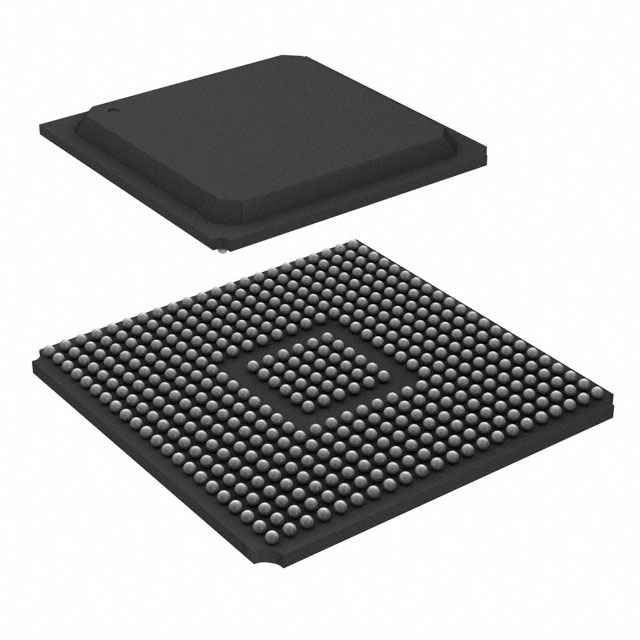XC3S2000-4FG456I
Product Overview
Category
The XC3S2000-4FG456I belongs to the category of Field-Programmable Gate Arrays (FPGAs).
Use
FPGAs are integrated circuits that can be programmed and reprogrammed to perform various digital functions. The XC3S2000-4FG456I is specifically designed for high-performance applications that require complex logic functions.
Characteristics
- High-performance FPGA with advanced features
- Large capacity and flexibility for complex designs
- Low power consumption
- Fast processing speed
- Programmable and reconfigurable
Package
The XC3S2000-4FG456I comes in a FG456 package, which refers to a Fine-Pitch Ball Grid Array (BGA) package with 456 balls.
Essence
The essence of the XC3S2000-4FG456I lies in its ability to provide a customizable hardware solution for a wide range of applications. It allows designers to implement complex digital systems without the need for custom-designed integrated circuits.
Packaging/Quantity
The XC3S2000-4FG456I is typically sold in trays or reels, with each containing a specific quantity of units. The exact packaging and quantity may vary depending on the supplier.
Specifications
- Logic Cells: 2,000
- Flip-Flops: 64,000
- Block RAM: 1,152 Kbits
- DSP Slices: 120
- Maximum Operating Frequency: 500 MHz
- I/O Pins: 456
- Voltage Range: 1.14V - 1.26V
Detailed Pin Configuration
The XC3S2000-4FG456I has 456 I/O pins, each serving a specific purpose in the overall functionality of the FPGA. A detailed pin configuration diagram can be found in the product datasheet.
Functional Features
- High-speed processing capabilities
- Configurable I/O standards
- On-chip memory resources
- Built-in digital signal processing (DSP) blocks
- Flexible clock management
- Support for various communication protocols
Advantages and Disadvantages
Advantages
- Versatility: Can be reprogrammed for different applications
- Rapid Prototyping: Allows for quick development and testing of digital systems
- Cost-Effective: Eliminates the need for custom-designed integrated circuits
- Flexibility: Can adapt to changing requirements without hardware modifications
Disadvantages
- Complexity: Requires expertise in FPGA programming
- Limited Resources: The capacity of the XC3S2000-4FG456I may not be sufficient for extremely large designs
- Power Consumption: FPGAs tend to consume more power compared to dedicated application-specific integrated circuits (ASICs)
Working Principles
FPGAs like the XC3S2000-4FG456I consist of an array of configurable logic blocks interconnected through programmable routing channels. These logic blocks can be programmed to perform specific functions, allowing designers to create custom digital circuits. The configuration of the FPGA is stored in non-volatile memory and can be modified as needed.
Detailed Application Field Plans
The XC3S2000-4FG456I finds applications in various fields, including:
- Telecommunications: Used in network routers, switches, and base stations.
- Aerospace and Defense: Employed in radar systems, avionics, and secure communications.
- Industrial Automation: Utilized in control systems, robotics, and machine vision.
- Medical Devices: Integrated into imaging systems, patient monitoring equipment, and diagnostic devices.
- Automotive: Applied in advanced driver-assistance systems (ADAS), infotainment systems, and engine control units.
Detailed and Complete Alternative Models
- XC3S5000-4FG900I: A higher-capacity FPGA with 5,000 logic cells and 900 I/O pins.
- XC3S1500-4FG320I: A lower-capacity FPGA with 1,500 logic cells and 320 I/O pins.
- XC3S100E-4FG320C: An economy-grade FPGA with 100 logic cells and 320 I/O pins.
These alternative models offer different capacities and pin configurations to suit specific project requirements.
In conclusion, the XC3S2000-4FG456I is a high-performance FPGA that provides designers with a flexible and customizable hardware solution for various applications. Its advanced features, large capacity, and reprogrammability make it a versatile choice for complex digital designs.
Lista 10 Vanliga frågor och svar relaterade till tillämpningen av XC3S2000-4FG456I i tekniska lösningar
Sure! Here are 10 common questions and answers related to the application of XC3S2000-4FG456I in technical solutions:
Q: What is XC3S2000-4FG456I? A: XC3S2000-4FG456I is a field-programmable gate array (FPGA) manufactured by Xilinx, with 2 million system gates and 2000 logic cells.
Q: What are some typical applications for XC3S2000-4FG456I? A: XC3S2000-4FG456I can be used in various applications such as digital signal processing, high-speed data communication, industrial automation, and embedded systems.
Q: How does XC3S2000-4FG456I differ from other FPGAs? A: XC3S2000-4FG456I offers a higher gate count and more logic cells compared to lower-end FPGAs, allowing for more complex designs and greater flexibility.
Q: What programming languages can be used to program XC3S2000-4FG456I? A: XC3S2000-4FG456I can be programmed using hardware description languages (HDLs) such as VHDL or Verilog.
Q: Can XC3S2000-4FG456I be reprogrammed after deployment? A: Yes, XC3S2000-4FG456I is a reprogrammable FPGA, which means its configuration can be changed even after it has been deployed in a system.
Q: What tools are available for designing with XC3S2000-4FG456I? A: Xilinx provides software tools like Vivado Design Suite that enable designers to create, simulate, and implement designs for XC3S2000-4FG456I.
Q: What is the power consumption of XC3S2000-4FG456I? A: The power consumption of XC3S2000-4FG456I depends on the design and operating conditions, but it typically ranges from a few hundred milliwatts to a few watts.
Q: Can XC3S2000-4FG456I interface with other components or devices? A: Yes, XC3S2000-4FG456I supports various communication protocols like SPI, I2C, UART, and Ethernet, allowing it to interface with other components or devices.
Q: Are there any limitations or considerations when using XC3S2000-4FG456I? A: Some considerations include the available I/O pins, clock frequency limitations, and resource utilization. It's important to carefully plan and optimize the design.
Q: Where can I find additional resources and support for XC3S2000-4FG456I? A: Xilinx provides documentation, application notes, forums, and technical support on their website to assist users in designing with XC3S2000-4FG456I.


